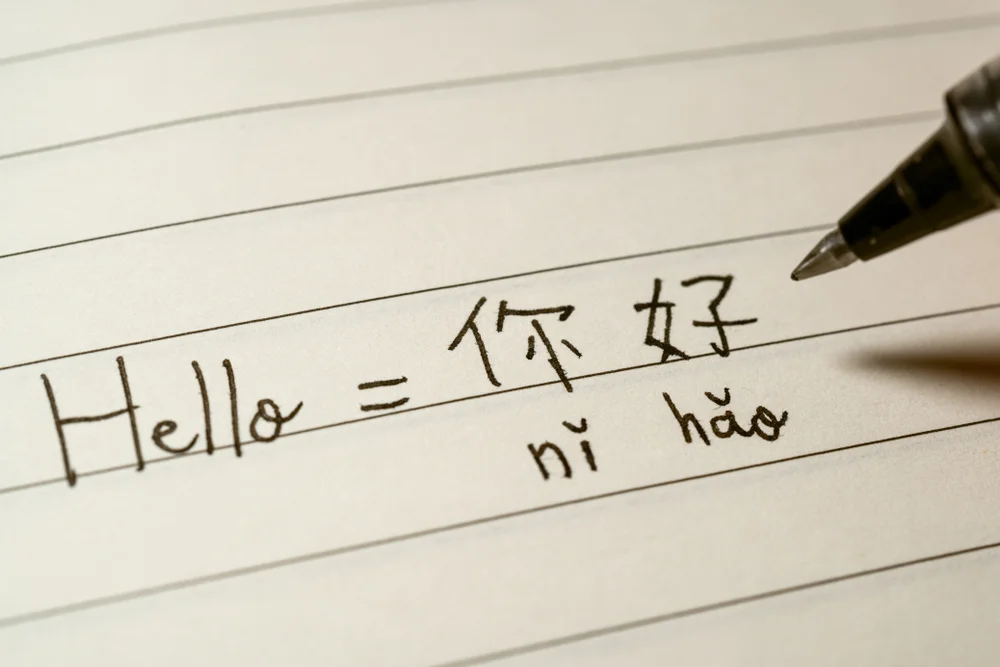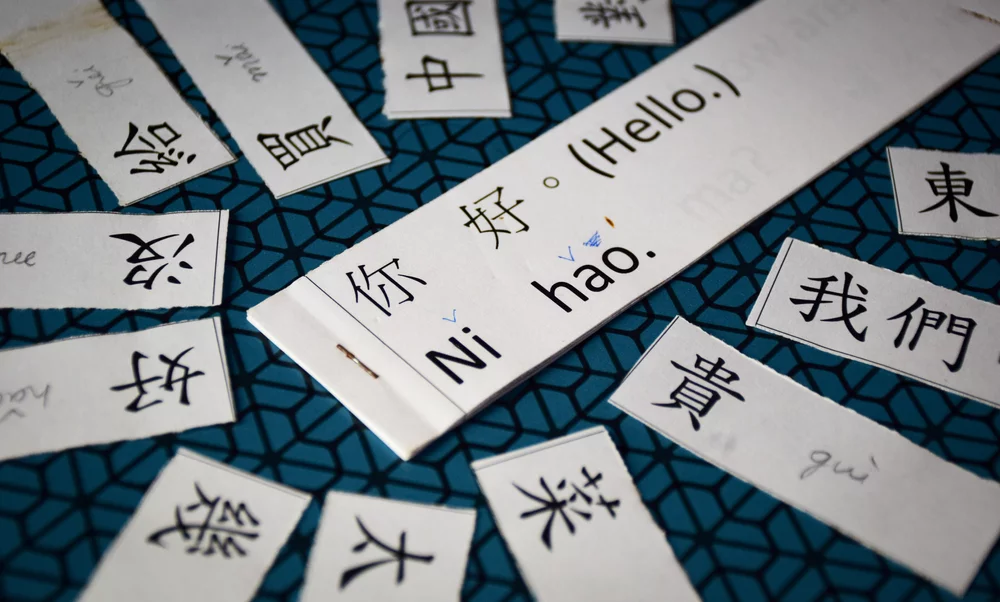Is Chinese Hard to Learn?

Language learning is an intriguing journey, often filled with rewarding milestones and challenging hurdles. To many, the question arises: “Is Chinese hard to learn?”
While the answer depends on numerous factors, there’s no denying the complexity and richness of Mandarin Chinese. Learning any foreign language is challenging, and Mandarin, with its unique tonal language characteristics and non-Latin script, can be a steep learning curve for some, especially native English speakers.
Mandarin Chinese: A unique language
Mandarin Chinese, the most widely spoken language in the world, has a linguistic structure quite distinct from European languages. One of the unique aspects of Mandarin Chinese is its tonal nature, with each syllable having a specific pitch pattern. This tonal language can be particularly challenging for speakers of non-tonal languages, as each tone can drastically alter the meaning of a word.
Another fundamental difference lies in the writing system. Unlike the Latin alphabet used in English and other European languages, Mandarin Chinese is written using logographic characters. Each Chinese character can represent entire words, providing a stark contrast to the Latin-based languages, where letters form words.
This distinct nature of Chinese characters may seem daunting at first, but with enough practice, one can learn to write the characters proficiently. It’s essential to note that learning Chinese involves mastering Chinese characters, both in their traditional Chinese and simplified Chinese forms.
Related Reading: How Chinese Words Work

So, Chinese is hard to learn?
Answering this question demands a deeper exploration into what makes learning Mandarin Chinese challenging for many. Firstly, the phonetic scripts, known as Pinyin, serve as the official romanization system for transcribing the Mandarin language’s sounds into the Latin alphabet. Understanding this system is crucial for getting a grip on Chinese pronunciation.
However, the real challenge comes in distinguishing the tones. Mandarin has four tones and a neutral tone, and variations in these tones can change the meaning of Chinese words. Therefore, to speak Chinese correctly, learners must grasp all the sounds, which can be a steep learning curve.
The Chinese language’s complexity doesn’t stop at tonal variations and Chinese characters. The grammar structure can also be tricky. While Chinese grammar lacks verb forms and tenses commonly found in English verbs, it comes with unique constructs that can pose a challenge for non-native speakers.
Learning Chinese words and phrases is one aspect of the challenge, but achieving conversational fluency is a whole different ball game. Conversational fluency requires not just advanced proficiency in speaking skills but also a deep understanding of Chinese culture and regional linguistic differences.
Language practice groups or dedicated Mandarin practice groups can play a pivotal role in mastering the nuances of spoken language and achieving conversational fluency. Chinese learners can greatly benefit from these interactive platforms that facilitate practical language engagement with native speakers and other language learners.
Related Reading: How to Memorize Chinese Words – 4 EXCELLENT Techniques

Learning Mandarin Chinese: A rewarding endeavor
Despite the complexities, learning Chinese is far from impossible. For English speakers, it may not be the easiest language to learn, but it’s certainly achievable with the right resources, perseverance, and dedication. The Chinese language’s intricacies add to the depth of the learning process, making mastering the language a rewarding accomplishment.
In this digital age, numerous resources are available to learn Mandarin Chinese, right from comprehensive Chinese dictionaries to online learning platforms. Regular practice of Mandarin, both spoken and written Chinese, is vital to mastering Chinese characters and understanding the language structure.
One significant advantage for English language learners is that Mandarin has fewer grammatical rules and exceptions compared to English and other European languages.
For example, Mandarin does not conjugate verbs or use plurals like other languages. This simplicity can make the language more accessible for new language learners.
And, of course, the influence of Chinese culture globally provides ample motivation to learn Mandarin Chinese. With Mandarin being the official language of Mainland China, a country with a rich history and growing influence in world affairs, understanding this language can open a plethora of opportunities, from career advancement to a deeper appreciation of Chinese culture.
Related Reading: Chinese Characters: Learn Them as Soon as Possible

Mandarin Blueprint: Your secret weapon
Now, let’s talk about an amazing resource that can make learning Chinese significantly easier and way more fun. Say hello to the Mandarin Blueprint. This method uses scientifically proven techniques to make learning Mandarin as natural and engaging as possible.
From understanding all the sounds to mastering Chinese characters, Mandarin Blueprint provides a comprehensive guide to tackle the most common challenges faced by Chinese learners.
With Mandarin Blueprint, you’ll be speaking and writing Chinese characters before you know it. You’ll even find yourself mastering the tones with ease! Mandarin Blueprint covers all aspects of learning Chinese, from basic phrases to conversational fluency, providing a holistic approach to language learning.
Related Reading: Chinese Fluency: How Long Does it Take with Mandarin Blueprint?
Tips and tricks for learning Chinese
Navigating the labyrinth of Chinese characters may seem a herculean task for most learners. However, a methodical approach to learning Mandarin Chinese can help alleviate some of these challenges. Here are some effective strategies to expedite the learning process:
- Start with the basics: Begin with learning the basic phrases and commonly used Chinese words. This foundational knowledge will aid in building vocabulary and give you confidence as you start speaking the language.
- Use technology: There are numerous mobile apps and online resources available to aid you in learning Chinese. These tools can help you practice Chinese pronunciation, write Chinese characters, and even understand regional linguistic differences.
- Engage with native speakers: Interaction with native speakers is an excellent way to improve your Mandarin. It offers the chance to learn from an educated native speaker, get the pronunciation right, and understand the cultural nuances that come with the language.
- Join language practice groups: Mandarin practice groups and language practice groups offer a community where you can practice speaking the language and get immediate feedback, thereby aiding in improving your conversational fluency.
- Consistent practice: As with any new language, learning Chinese requires consistent practice. The more you speak and write, the quicker you’ll progress. It is beneficial to keep a dedicated time for Mandarin language practice daily.
Related Reading: SMART Goals for Learning Chinese

The beauty of Chinese characters: An art and a language
Alright, here comes the fun part. One of the most visually striking aspects of the Chinese language is undoubtedly its writing system. If you’ve ever found yourself mesmerized by the intricacy of Chinese characters, you’re not alone.
Writing Chinese characters is a whole different experience compared to writing in the Latin alphabet. It’s not just a writing system; it’s an art form. Every stroke, line, and angle holds meaning. Plus, did you know that these characters can represent entire words? Talk about efficiency.
“But wait,” you may be wondering, “isn’t mastering Chinese characters super hard?”
Well, yes and no. It’s true that there are thousands of Chinese characters out there, but here’s a secret: you only need to know about 3,000-4,000 characters to be able to read a newspaper or engage in a decent conversation. And once you’ve got the hang of some basic characters, you’ll start recognizing patterns and see that they’re not as daunting as they seem.
Related Reading: Best Resources for Learning Chinese
Let’s get tonal
Next up on our Mandarin adventure is the tonal system. Chinese is a tonal language, meaning that the pitch or tone you use can completely change a word’s meaning. This is a completely new concept for English speakers and speakers of most Western languages, but that’s what makes it exciting!
The Mandarin tonal system consists of four tones and a neutral tone. It might sound like a lot at first but don’t panic. With a little practice and the right tools, you’ll be toning like a pro in no time. Learning the tones not only helps you speak Chinese accurately but can also gives you a deeper understanding of the richness and precision of the language.
So there you have it: “Is Chinese hard to learn?” It’s not the easiest language, sure, but it’s far from impossible. In fact, it’s a language filled with beauty, precision, and richness. With resources like the Mandarin Blueprint, your curiosity, and a dash of excitement, you’re all set for a thrilling Mandarin learning journey. Let the adventure begin!
Related Reading: Can You Learn Chinese in 5 Minutes?

Embrace the journey: Celebrate each step
Alright, we’ve covered the unique writing system and the fascinating tonal system of Mandarin Chinese. It’s clear that learning Chinese is quite the adventure, but how do you make it a fun and rewarding journey? Here are some tips to keep your spirits high and your motivation strong.
Remember your “why”
Everyone has their own reason for wanting to learn Mandarin Chinese. Whether it’s to understand Chinese culture more deeply, connect with Chinese people, expand your career opportunities, or just to take on a new challenge, remember this motivation when things get tough.
Celebrate progress
Learning a language, especially Mandarin Chinese, isn’t an overnight process. It’s a journey with highs and lows, easy strides, and challenging hurdles. However, each step, no matter how small, is progress. Celebrate every new word you learn, every sentence you form, and every conversation you have.
Related Reading: Basic Chinese Sentence Structure
Seek out language partners
Join language practice groups or Mandarin practice groups. These communities provide an excellent platform for practicing speaking skills, understanding regional linguistic differences, and sharing learning tips and tricks. It also adds a social aspect to your language-learning journey.
Enjoy Chinese culture
Dive into Chinese movies, music, literature, and even cuisines. Enjoying the culture can make your language-learning journey more exciting and provide a greater context for your studies. Plus, it’s a great excuse to watch more movies and eat delicious food, right?
Related Reading: 22 Good Chinese TV Shows to Learn Mandarin
Don’t fear mistakes
Making mistakes is a crucial part of the learning process. Whether it’s stumbling over the tones or mixing up similar-sounding words, it’s all part of the journey. Each mistake is a stepping stone to mastering Mandarin Chinese.
Enjoy the ride
Last but not least, have fun! Learning Mandarin Chinese is a journey filled with excitement, discovery, and personal growth. It might be hard to learn, but it’s also incredibly rewarding and enjoyable. Embrace the learning process and enjoy each moment.

Ready to start learning Chinese?
How hard Chinese is to learn largely depends on the learner’s dedication, resources, and learning strategies. It is undeniably one of the more difficult languages to learn, particularly for native English speakers or those familiar with European language structures. However, with the right attitude and tools, it’s possible to achieve proficiency in Mandarin Chinese.
It’s also important to remember that learning a language is not a sprint but a marathon. You don’t have to understand and master everything immediately. Take your time and enjoy the journey of exploring a new language. After all, every step taken in learning Mandarin Chinese, no matter how small, leads to a greater understanding of the language and its rich cultural heritage.
Just as an English language learner may struggle with the idiosyncrasies of English verbs, or an Italian learner may stumble over verb forms, the journey of learning Mandarin Chinese is filled with challenges. However, these hurdles are what makes the learning journey enriching and worthwhile. With every Chinese character mastered, with every tonal pronunciation nailed, you’re not only learning a new language but also gaining a broader perspective on one of the world’s oldest cultures.
So, is Chinese a difficult language to learn? Yes, but every challenge faced is an opportunity for growth and deeper understanding, making learning Mandarin Chinese a rewarding endeavor.
Related Reading: Mandarin Blueprint Case Study








